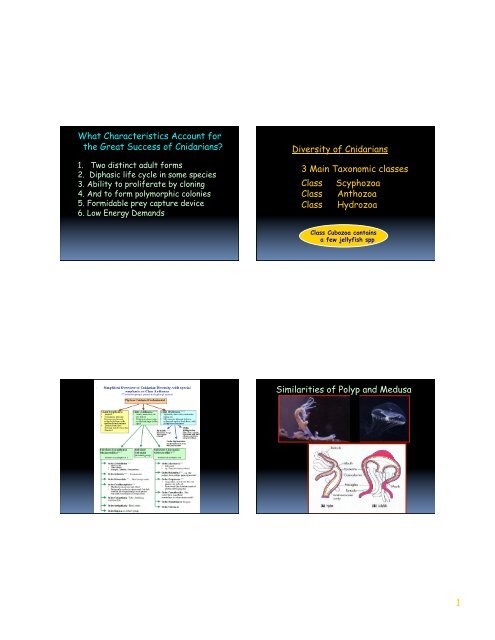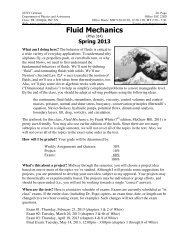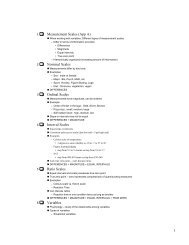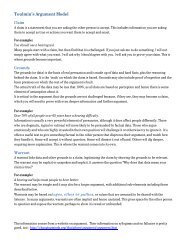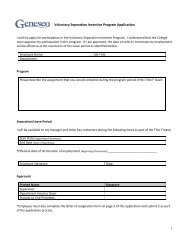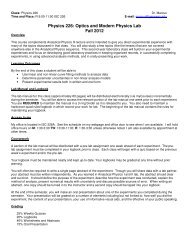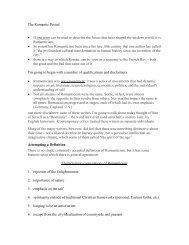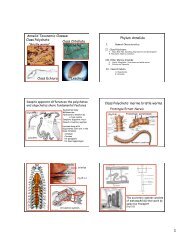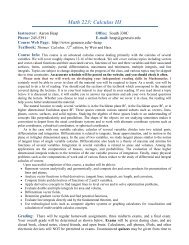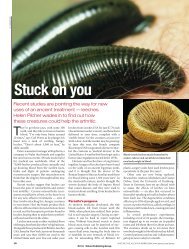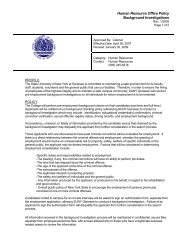What Characteristics Account for the Great Success of Cnidarians ...
What Characteristics Account for the Great Success of Cnidarians ...
What Characteristics Account for the Great Success of Cnidarians ...
You also want an ePaper? Increase the reach of your titles
YUMPU automatically turns print PDFs into web optimized ePapers that Google loves.
<strong>What</strong> <strong>Characteristics</strong> <strong>Account</strong> <strong>for</strong><br />
<strong>the</strong> <strong>Great</strong> <strong>Success</strong> <strong>of</strong> <strong>Cnidarians</strong>?<br />
1. Two distinct adult <strong>for</strong>ms<br />
2. Diphasic life cycle in some species<br />
3. Ability to proliferate by cloning<br />
4. And to <strong>for</strong>m polymorphic colonies<br />
5. Formidable prey capture device<br />
6. Low Energy Demands<br />
Diversity <strong>of</strong> <strong>Cnidarians</strong><br />
3 Main Taxonomic classes<br />
Class Scyphozoa<br />
Class Anthozoa<br />
Class Hydrozoa<br />
Class Cubozoa contains<br />
a few jellyfish spp<br />
Similarities <strong>of</strong> Polyp and Medusa<br />
1
Epi<strong>the</strong>leomuscular<br />
cells<br />
cnidocytes<br />
Nutritive<br />
muscular<br />
cells<br />
Gland<br />
cells<br />
mesoglea<br />
Epi<strong>the</strong>liomuscular Cells<br />
and gastromuscular cells<br />
Lacking mesoderm, but muscles derived<br />
from epi<strong>the</strong>lial endodermal and ectodermal cells<br />
How is it that organisms as different<br />
As jellyfish, hydroids and anemones<br />
Can be classified in <strong>the</strong> same phylum?<br />
1. Nematocysts: unique stinging cells<br />
2. Diploblastic: 2 cell layers separated by acellular<br />
mesoglea (“middle jelly”); epi<strong>the</strong>liomuscular cells<br />
3. Primary radial symmetry<br />
4. No head, no CNS, no circulatory or excretory<br />
systems and no discrete respiratory structures<br />
5. Dimorphism <strong>of</strong> adult <strong>for</strong>m; in life cycle<br />
6. 2- way digestive system<br />
7. nerve net<br />
2
Giant jellyfish invade Japan<br />
Hydromedusa <strong>for</strong><br />
comparison<br />
Seven synapomorphies:<br />
Life history (4): large size, rapid growth, high fecundity,<br />
asexual reproduction by polyps<br />
Morphology (1): strong swimmers/ High Reynolds number<br />
Diet (2):: varied diet/specialize on microzooplankton,<br />
(have rizhostome tentacles); lack <strong>of</strong> symbionts<br />
• Small a few cm<br />
• Velum to aid in locomotion<br />
• Radial canals unbranched<br />
• Simple epidermal and endodermal nerve net<br />
• Nematocysts usually small without toxins<br />
<strong>Characteristics</strong> <strong>of</strong> <strong>the</strong> Scyphozoa<br />
stomach<br />
mouth<br />
mesoglea<br />
gastric pouch<br />
gonad<br />
radial canal<br />
gastrodermis<br />
Radial<br />
canal<br />
<strong>Characteristics</strong> <strong>of</strong> <strong>the</strong> Scyphozoa<br />
(Adaptations to a drifting, carnivorous lifestyle)<br />
G-V cavity more<br />
complex, adapted<br />
to subdue and<br />
digest larger and<br />
active prey<br />
Stomach<br />
G-V Canals<br />
MOUTH<br />
Gastric Pouches<br />
MANUBRIUM<br />
3
<strong>Characteristics</strong> <strong>of</strong> <strong>the</strong> Scyphozoa<br />
(Adaptations to a drifting, carnivorous lifestyle)<br />
Coronal<br />
Muscle<br />
and<br />
swimming<br />
G-V cavity more<br />
complex, adapted<br />
to subdue and<br />
digest larger and<br />
active prey<br />
How is swimming pace, direction coordinated?<br />
Associated with<br />
coronal muscles…<br />
Sensory neurons,<br />
motor neurons,<br />
Inner and outer<br />
nerve rings<br />
Marginal ganglia<br />
associated with<br />
rhopalia that<br />
constitute a<br />
pacemaker<br />
<strong>Characteristics</strong><br />
<strong>of</strong> <strong>the</strong> Scyphozoa<br />
(Adaptations to a drifting,<br />
carnivorous lifestyle)<br />
The nervous system<br />
is more complex;<br />
unique sensory<br />
structures<br />
Nerve net shared by<br />
all Cnidaria<br />
To ganglia<br />
4
Rhopalium<br />
24 eyes but no brain<br />
(Digestive)<br />
Marginal ganglia<br />
Inner and outer nerve rings<br />
Coronal muscles<br />
Nerve net<br />
Epiheliomuscular system<br />
Rhopalia are Intergrated with Nerve Rings<br />
Garm et al., 2006<br />
Cell Tissue Research #325<br />
When did a Centralized Nervous System Evolve?<br />
“Conventional” view<br />
Marlow et al., 2009, Developmental Neurobiology<br />
5
Cnidarian nerve net e.g. Hydra<br />
“Sub-functionalized” N.S.<br />
Sea Anemone Nematostella<br />
Nerve rings are Core <strong>of</strong> CNS in medusae<br />
-- Concentrations <strong>of</strong> hundreds <strong>of</strong> axons in parallel <strong>for</strong>m coupled nerve rings.<br />
Having an annular <strong>for</strong>m ra<strong>the</strong>r than a large ganglion does not make it<br />
less centralized.<br />
-- The annular configuration is a function <strong>of</strong> radial symmetry<br />
Mackie, 2004. Neurosignals #13<br />
6


